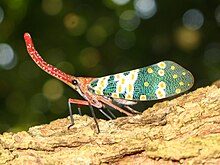Genus of planthoppers
Pyrops
Pyrops candelaria
Scientific classification
Domain:
Eukaryota
Kingdom:
Animalia
Phylum:
Arthropoda
Class:
Insecta
Order:
Hemiptera
Suborder:
Auchenorrhyncha
Infraorder:
Fulgoromorpha
Superfamily:
Fulgoroidea
Family:
Fulgoridae
Subfamily:
Aphaeninae
Tribe:
Pyropsini
Genus:
Pyrops Spinola , 1839
Type species
Pyrops candelaria (Linnaeus, 1758)
Synonyms
Laternaria Linnaeus, 1764 (Suppressed) Lanternaria Linnaeus, 1764 (Missp.) Byrops Spinola, 1839 (Missp.) Pyrophorus Spinola, 1839 (Missp.) Pyropi Spinola, 1839 (Missp.) Hotinus Amyot & Audinet-Serville, 1843 Hotina Amyot & Audinet-Serville, 1843 (Missp.) Hotini Amyot & Audinet-Serville, 1843 (Missp.)
Pyrops planthoppers that occur primarily in southeast Asia, containing about 70 species.[ 1]
Species
The genus has been divided into several species groups:[ 2] [ 3] [ 4] [ 5] [ 6]
Candelaria group
Pyrops lathburii Pyrops aeruginosus (Stål, 1870) Pyrops agusanensis (Baker, 1925) Pyrops atroalbus (Distant, 1918) Pyrops auratus Constant, 2021 Pyrops azureus Constant & Mohan, 2017 [ 7] Pyrops buomvoi Constant & Pham, 2022 [ 8] Pyrops candelaria (Linnaeus , 1758 ) – type species Pyrops coelestinus (Stål, 1863) Pyrops condorinus (Lallemand, 1960) Pyrops connectens (Atkinson, 1885) Pyrops curtiprora (Butler, 1874) - Actually a Saiva Pyrops delessertii (Guerin-Meneville, 1840) Pyrops dohrni (Schmidt, 1905) Pyrops ducalis Stål, 1863 Pyrops exsanguis (Gerstaecker , 1895) Pyrops farinosus Bierman, 1910 Pyrops fumosus (Baker, 1925) Pyrops heringi (Schmidt, 1905) Pyrops hobbyi (Lallemand, 1939) Pyrops jasmini Chew Kea Foo, Porion & Audibert, 2010 Pyrops jianfenglingensis Wang, Xu & Qin, 2018 Pyrops karenius (Distant, 1891) Pyrops kozlovi Porion & Audibert, 2020 Pyrops lathburii (Kirby, 1818) [ 9] Pyrops lautus (Stål, 1870) Pyrops maculatus (Olivier , 1791) Pyrops maquilinganus (Baker, 1925) Pyrops nishiyamai Nagai & Porion, 2002 Pyrops ochraceus Nagai & Porion, 1996 Pyrops peguensis (Schmidt, 1911) Pyrops philippinus (Stål, 1870) Pyrops polillensis (Baker, 1925) Pyrops priscilliae Nagai, Porion & Audibert, 2016 Pyrops rogersi (Distant, 1906) Pyrops spinolae (Westwood , 1842) Pyrops viridirostris (Westwood , 1848) Pyrops vitalisius (Distant, 1918) Pyrops zephyrius (Schmidt, 1907)
Clavatus group
Effusus group
Oculatus group
Polillensis group
Pyrorhynchus group
Pyrops ruehli
Sultana group
Ungrouped species
Taxonomy
The genus name of Laternaria has been used by some authors, but this name was published in a work that was suppressed in 1955 by an official declaration of the International Code of Zoological Nomenclature (ICZN): Opinion 322.[ 10] [ 11] type species is Pyrops candelaria
A molecular phylogenetic study suggests that Pyrops is sister to the genus Saiva [ 12]
Ecology
Like many other plant-sap sucking insects, Pyrops species exude honeydew. This honeydew is sometimes gathered by other animals in trophobiotic associations. Pyrops whiteheadi and P. intricatus are known to be attended by Dorylaea cockroaches in Southeast Asia. Pyrops whiteheadi has also been seen tended by a gecko, Gehyra mutilata [ 13]
References
^ Spinola, M (1839). "Essai sur les Fulgorelles, sous-tribu de la tribu des Cicadaires, ordre des Rhyngotes" . Annales de la Société Entomologique de France . 8 : 339– 454. ^ "Asian Lanternflies: The genus Pyrops · iNaturalist" .^ Nagai Shinji; Porion Thierry; Cédric Audibert (February 2017). "Pyrops nishiguroi n. sp., a new Fulgoridae from Philippines, with some notes on the Pyrops oculatus group (Hemiptera: Fulgoromorpha)" . Faunitaxys . 5 (1): 1– 5. ^ Sheryl Yap; Ace Kevin Surara Amarga; Jérôme Constant (October 2017). "The new polillensis group in the lanternfly genus Pyrops : Taxonomy, distribution and host plant (Hemiptera: Fulgoridae)" . Belgian Journal of Entomology . 55 : 1– 14. ^ Jérôme Constant; Kawin Jiaranaisakul (February 2021). "The Oriental lanternfly Pyrops itoi (Satô & Nagai, 1994): New synonymy and distribution records (Hemiptera: Fulgoromorpha: Fulgoridae)" . Belgian Journal of Entomology . 110 : 1– 14. ^ Jérôme Constant; Thai Hong Pham (March 2017). "Review of the clavatus group of the lanternfly genus Pyrops (Hemiptera: Fulgoromorpha: Fulgoridae)" . European Journal of Taxonomy . 305 : 1– 26. doi :10.5852/ejt.2017.305 . ^ Constant, Jérôme & Mohan, Ashwini Venkatanarayana (2017). "The lanternflies from Andaman and Nicobar: one new Pyrops species, new records and illustrated key to the species (Hemiptera: Fulgoromorpha: Fulgoridae)". Belgian Journal of Entomology . 49 : 1– 24. ^ Jérôme Constant; Thai Hong Pham (April 2022). "The Lanternfly genus Pyrops in Vietnam: A new species from Central Vietnam, taxonomic changes, checklist, identification key (Hemiptera: Fulgoromorpha: Fulgoridae)" . European Journal of Taxonomy . 813 (1): 123– 154. doi :10.5852/ejt.2022.813.1741 . ^ "TaxonPages: World Auchenorrhyncha Database - Pyrops lathburii (Kirby, 1818)" .^ ICZN (1955). "Opinion 322. Validation, under the Plenary Powers, of the generic name Fulgora Linnaeus, 1767 (Class lnsecta, Order Hemiptera) and designation for the genus so named of a type species in harmony with current nomenclatorial practice" . Opinions and Declaractions Rendered by the International Commission on Zoological Nomenclature . 9 (13): 185– 208. doi :10.5962/p.149561 . ^ Fennah, R. G. (1951). "Proposed use of the plenary powers to designate a type species for the genus "Fulgora" Linnaeus 1767, and to suppress the generic name "Laternaria" Linnaeus 1764 (class Insecta, order Hemiptera)" . Bulletin of Zoological Nomenclature . 6 : 34– 37. doi :10.5962/bhl.part.15979 ^ Urban, Julie M. & Cryan, Jason R. (2009-03-01). "Entomologically famous, evolutionarily unexplored: The first phylogeny of the lanternfly family Fulgoridae (Insecta: Hemiptera: Fulgoroidea)". Molecular Phylogenetics and Evolution . 50 (3): 471– 484. Bibcode :2009MolPE..50..471U . doi :10.1016/j.ympev.2008.12.004 . PMID 19118634 . ^ Constant, Jérôme (2015-07-08). "Review of the effusus group of the lanternfly genus Pyrops Spinola, 1839, with one new species and notes on trophobiosis (Hemiptera: Fulgoromorpha: Fulgoridae)" . European Journal of Taxonomy (128): 1– 23. doi :10.5852/ejt.2015.128
External links


